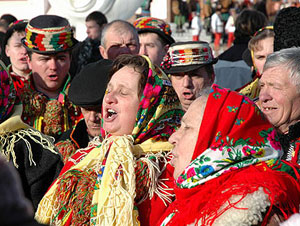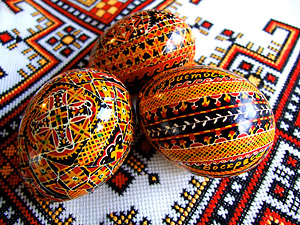- About Ukraine
- Hutsuliya
- Rest and Tourism
- Photograph Album
- Library
- Hutsul Legends
- Hutsul Customs and Traditions
- The Carpathian Pastoral
- Hutsul’s Hospitality and Politeness
- Hutsul Wedding
- The Wedding Day In Kosiv
- Hutsul Holidays and Traditions
- Hutsul Folk Art
- Feed
- Store
There are a number of holidays which are celebrated all over the world at least in Europe and America, for sure. There may be modifications in the way of celebration and traditions in different countries but at the same time there is much in common.
Most of these holidays are very ancient and connected either with Christianity like Christinas and Easter, or with much more ancient pagan cults which worshiped Nature (like seeing seasons in and off).

Not long ago Ukrainian Cultural Foundation called for the revival of folk rites such as Kolyadky (Christmas carols) and vertep, for example.
Vertep is the New Year Costume show. Traditionally, the plot of the vertep is based on a legend from the Bible telling about the birth of Jesua Christ. The action usually shows the triumph of good and justice over evil.
The most active figures of the vertep are King Herold, shepherds, the Angel, the Death, warriors and three Kings.
Carolling is an ancient custom. The first carols were sung in 1223 in Italy. In Ukraine the singers go from home to home, wishing people all the best in the New Year.

One might see not once candles in the windows on Christmas Eve. The Bible says that Mary had trouble finding shelter on the night Jesus was born. So on Christmas Eve, some people light candles in the window. The candles symbolize a welcome to cold and weary travellers.
One of the favourite holidays of most children in this country is New Year. On New Year’s Eve people send one another New Year cards. They wish one another good health and happiness. Many families, especially those with small children have a New Year tree. The tree, traditionally a fir tree, is decorated with artificial snow, glass balls, chocolates wrapped in silver paper. The tree is also decorated with “fairy lights”, small multi-coloured electric lamps, shaped like candles or snow flakes. Festivities for children are held these days. Children wait for Santa Claus and get gifts.
Santa Claus gets his name from a man known as St. Nicholas, St. Nicholas lived in Western Asia in the fourth century. He gave his wealth to the poor — often children. After he died, his feast day was celebrated with gift giving. The Dutch who called him Sinter Klaas brought his legend to colonial America, where the Dutch variant of the name “Sinter Klaas” transformed into Santa Claus. His name was transformed during the ages in different countries in different ways. But the image of the mar ving the gifts to children and the tradition of gift giving is still preserved.

There are many ancient legends, fairy tales and songs about Easter eggs. Pagan beliefs regarded them as symbols of spring, of the sun and the awakening of Nature. Small twigs flowers, bushes, leaves, fir-trees which are usually drawn on them ere all the elements of the theme of “the tree of life”. Long ago people believed that Easter eggs had magic power 9nd savedthe house from being struck by lightning. Easter is celebrated as a religious festival and as the start of spring when new life comes to the earth. Christians rejoice over the fact that Jesus rose from the dead. This holy day never comes before March 22 or after April 25. The Egg, the symbol of life, is often a pert of Easter games and festivities. Flowers are also used to signify the Nature’s reawakening.
Long since people have welcomed spring. Good-bye to Winter festival is traditionally organized on one of the Sundays of March. It symbolizes the meeting of winter with spring, during which winter gives over its powers to spring and informs it on how people have prepared for it. In many administrative districts and regions of Ukraine farm equipment is examined these days. The preparations for this popular festival begin well in advance. Father Frost (Santa Claus), Snow Maiden and their assistants, Heralds, go along the streets in open cars or in sledges inviting people to participate in the festivities. The Spring, played by a festively dressed girl, greets the crowds. Organized in different ways depending on the town or the village where it is held, this holiday with songs, dances, interesting games, shows and competitions make people joyful and happy.

